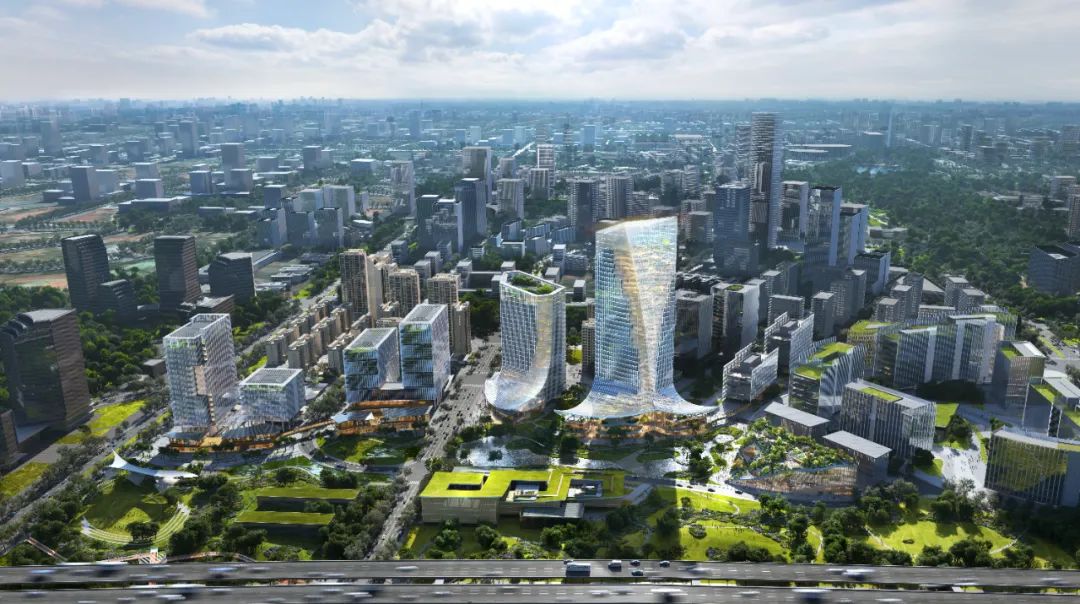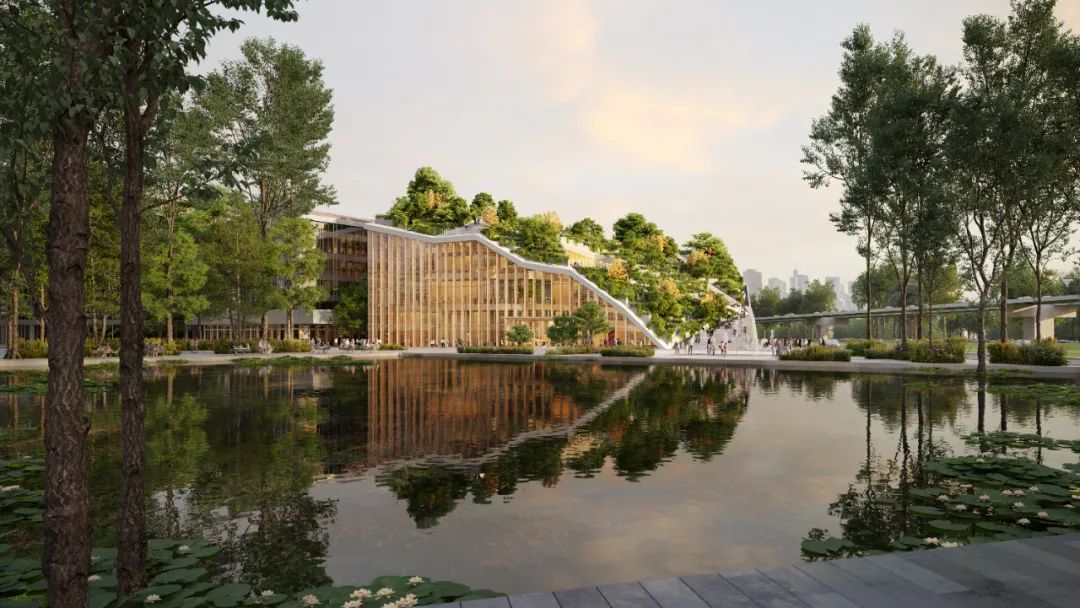- 注册
- 登录
- 小程序
- APP
- 档案号


MVRDV · 2023-10-20 07:35:16

图片 Image: © MVRDV
MVRDV 中标成都天府软件园二期地块内两座建筑的设计竞赛。园区的核心地块分布一栋规划限高150米的办公塔楼,其中一侧设有整楼通高的中庭,中庭空间垂直分布着茂盛的绿植,延伸至底部时向外展开。整座中庭采用网状立面,是建筑气候系统的关键功能元素。另一座建筑是一个四层楼高的文化中心,内部设置了艺术博物馆、会议厅、图书馆和展览空间。这座文化建筑以多斜面的立面形态,将来访者引导至绿色的屋顶空间和梯田式的室内空间。
MVRDV has won the competition to design the two buildings on a plot within Tianfu Software Park Phase II in Chengdu. The dramatic centrepiece of the campus is a 150-metre-tall office tower, which includes on one corner a full-height atrium with lush cascading greenery. This atrium is open at the base and uses a mesh façade, thus serving as a key functional element of the building’s climate system. Also included on the campus is a four-storey cultural centre with an art museum, conference hall, library, and exhibition space. With its faceted sloping form, this cultural building invites visitors to climb both its green roof and its terraced interior.

图片 Image: © MVRDV
该项目由成都高新投资集团开发,将为专注于发展 5G、人工智能、大数据、卫星互联网和其他高科技领域的企业提供办公和公共场所。项目位于成都东南部,坐落在城市扩张与乡村丘陵地貌区域的部分边界,MVRDV将城市与自然的交汇作为设计的重要出发点。绿色植被从公园空间延伸到建筑内部。在办公塔楼中,景观自下而上延伸形成绿色中庭,文化中心的绿色植物则散布在屋顶空间。
The project is developed by Chengdu High-Tech Investment Group, and will be home to companies focused on the development of 5G, AI, big data, Satellite Internet, and other high-tech interests. Located in the southeast of Chengdu, it occupies part of the boundary between Chengdu’s urban expansion and a hilly rural area; this meeting point of city and nature formed a crucial starting point for the design. Fingers of greenery extend from this park space into the buildings. In the office tower, this finger of greenery extends upwards to form the atrium, while on the cultural centre, greenery proliferates over the roof.

图片 Image: © MVRDV
MVRDV设计的办公塔楼采用了优化的楼层平面,最大程度上保留了东面山脉景观的视野。垂直中庭本身也成为一个半户外空间:自上而下地延展,形成优雅的曲线,在底部区域自然地与商业裙楼融为一体;为了进一步满足建筑的气候策略,中庭区域采用透明的网状立面,作为缓冲区,通过网格结构和相对立面的可开启面板进行被动式交叉通风,同时减少了办公空间内的阳光直射。中庭的绿色景观为露台带来荫蔽,有助于减少办公空间对人工制冷的需求,从而降低建筑物的能耗。
The office tower is shaped to optimise floor plates and maximise views of the mountains to the east. The atrium forms a semi-outdoor space: it is open at its base, where swooping lines gradually merge with a shopping podium, and it is enclosed by a mesh façade. This allows it to contribute to the building’s climate strategy, the atrium acting as a buffer zone that allows passive cross-ventilation through the mesh and via openable panels in the opposite façades, while reducing solar gain within the office spaces. As a result, it shades the terraces and helps to reduce the cooling requirements of the office spaces, reducing the building’s energy use.

图片 Image: © MVRDV
文化中心的建筑形态依循场地的三角形平面。不同的功能采用阶梯式的排列,向上层层退进,形成面向公园的露台。一个由多面三角形板组成的绿色屋顶覆盖了着整座“梯田”,形成半室外的中庭空间,同时将内部空间包裹起来。屋顶上有一部分面板被抬起,采用玻璃天窗,将日光引入室内。屋顶本身就是一个小型公园,设有公共广场、连续的步道和葱郁的植物,将景观从地面延伸到倾斜的建筑顶部。
The shape of the Culture Centre follows the triangular outline of the site. The different programmes are stacked on top of each other in a stepped arrangement to form terraces that are oriented towards the park. A green roof of faceted triangular panels covers the terraced interior to create a semi-outdoor atrium space that wraps up and over the interior spaces. At various points on the edges of the roof, the panels are lifted up to form glazed clerestory windows, allowing daylight into the interior. The roof is a small park in itself, equipped with public plazas, a continuous pathway, and lush green planters that extend the landscape on top of the sloping building.
MVRDV的设计方案呼应了成都天府软件园二期“公园城市”的愿景,在国际设计竞赛的诸多方案中脱颖而出。天府软件园二期各地块将于2023年底陆续开工建设,计划于2026年前后陆续建成。建成后的天府软件园二期将成为融合成都城市与自然的产业集群生态园,促进科学、技术、艺术、文化和商业在城市发展中的共生共荣。
MVRDV’s proposal echoes with the Park City vision of Chengdu and was selected as the winner of the international competition. Different plots of the Tianfu Software Park Phase II will start construction in end 2023, after the completion, which is planned for 2026, it will become an eco-park of industrial clusters that merges the city and the nature of Chengdu, fostering science, technology, art, culture, and commerce in an interdisciplinary extension of the city.

MVRDV建筑规划事务所由Winy Maas、Jacob van Rijs和Nathalie de Vries创立于荷兰鹿特丹,致力于为当代的建筑和都市问题提供解决方案。MVRDV的创作基于深度研究与高度协作,各领域的专家、客户及利益相关方从项目初期一直参与设计的全过程。直率而真诚的建筑、都市规划、研究和装置作品堪称典范,让城市和景观朝向更美好的未来发展。
MVRDV的早期项目,如荷兰公共广播公司VPRO的总部,以及荷兰阿姆斯特丹的WoZoCo老年公寓,都获得了广泛的国际赞誉。MVRDV250余位建筑师、设计师和城市规划师在多学科交叉的设计过程中,始终坚持严格的技术标准和创新性研究。MVRDV采用BIM技术,公司内拥有正式的BREEAM和LEED顾问。MVRDV与荷兰代尔夫特理工大学合作运营独立智库和研究机构The Why Factory,通过展望未来都市,为建筑及都市主义提供发展议程。
MVRDV was set up in 1993 in Rotterdam, The Netherlands by Winy Maas, Jacob van Rijs and Nathalie de Vries. MVRDV engages globally in providing solutions to contemporary architectural and urban issues. A research-based and highly collaborative design method engages experts from all fields, clients and stakeholders in the creative process. The results are exemplary and outspoken buildings, urban plans, studies and objects, which enable our cities and landscapes to develop towards a better future.
Early projects by the office, such as the headquarters for the Dutch Public Broadcaster VPRO and WoZoCo housing for the elderly in Amsterdam lead to international acclaim. 250 architects, designers and other staff develop projects in a multi-disciplinary, collaborative design process which involves rigorous technical and creative investigation. MVRDV works with BIM and has official in-house BREEAM and LEED assessors. Together with Delft University of Technology, MVRDV runs The Why Factory, an independent think tank and research institute providing an agenda for architecture and urbanism by envisioning the city of the future.
特别声明
本文为自媒体、作者等档案号在建筑档案上传并发布,仅代表作者观点,不代表建筑档案的观点或立场,建筑档案仅提供信息发布平台。
17
好文章需要你的鼓励

 参与评论
参与评论
请回复有价值的信息,无意义的评论将很快被删除,账号将被禁止发言。
 评论区
评论区